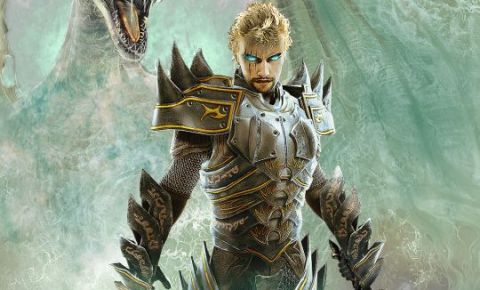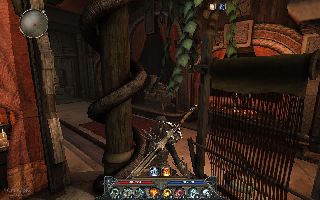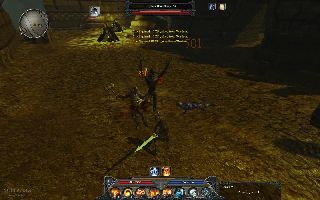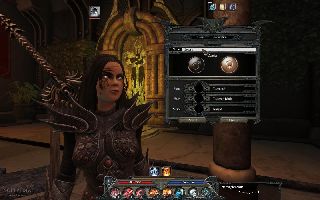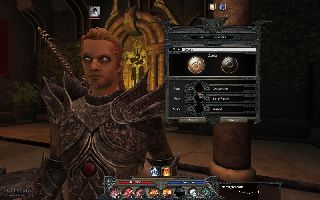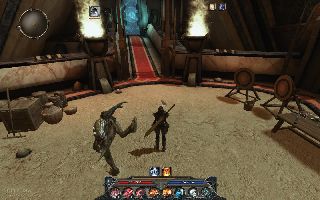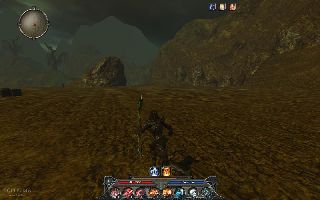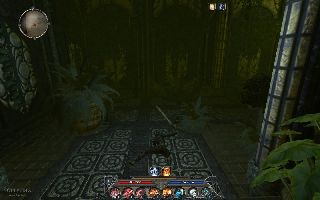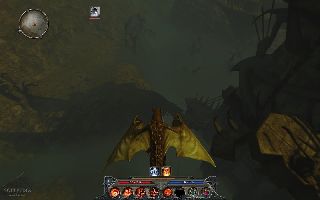Pulled straight out of a quarry, Divinity II Ego Draconis is an unpolished, rough, almost-untouched-by-human-hands rock. It has more sharp edges than one can count and it’s as dense as kryptonite. It’s definitely not a gem, and it’s not a precious stone of any kind, but while you won’t get much of a price at the local vendor if you are foolish enough to try and sell it, what you will get is plenty of fun with it if you choose to keep it. While its rough edges are a real pain in the neck at times, and you’ll probably cut yourself more often than not, the stone’s thickness will prove fascinating, for placing it in direct sunlight will cause a hundred of different crystals to generate a hypnotizing kaleidoscope.
Story
The game was rather fond of spoiling the big surprise as soon as the first shout out from Larian Studio came about it, as trailers and teasers told everyone that we’d turn into a dragon and soar to the skies. Because of this, what could have been a rather surprising turning point in the plot became even more predictable than it already was. As such, starting the game as a Dragon Slayer is a confusing moment, and we can’t help but wonder if out ideological path won’t push us into suicide somewhere into it. As a Dragon Slayer, out goal in life is to rid the world of the Dragon Knights' abominations, but since it’s obvious that we’ll soon become one of them, it’s a little bit hard, if not downright impossible, to put any heart and soul into the first hours of the game.
As far as the general plot goes, the title falls in line with its general attitude. Larian does try to give us a villain to duel against but the black-and-white boundaries of good and evil are very murky and it’s very hard to have a clear North or South on your moral compass. We run across this Damian on several occasions, the first time being rather early on in the game, and it’s very hard to hate the guy. We’re the only ones foolish enough to oppose him, so for better or for worse, we’re the only ones that can get in the way of his plan. And while he knows this very well, he’s not in any hurry to dispose of us. If anything, he tries to gives us a gentle nudge hoping we’ll get the subtle hint to leave him alone.
He’s like the father that’s trying to deal with his rebellious son. The old man has a plan and an important duty to perform, but the ignorant, little brat tries to get in his way just to defy him. The way he’s portrayed, along with the voice acting behind him has us wondering at some points if he’s not actually a good guy that tries to perform the lesser evil. As we progress, we find more about his reasons, but even so, it’s very hard to pin a “bad guy” label on him.Concept
While Divinity II is an obvious fantasy RPG, there’s one tiny, little detail that Larian just couldn’t make up its mind about when designing the game. While it’s mostly an action RPG, there are plenty of times when the title comes off as a Hack and Slash, and its difficulty sways back and forth between these extremes, pitting us against every possible combination of quality and quantity. Few and weak, few but strong, score and… well, it’s never easy to deal with an army by yourself, but at least it is easy to chip away at its numbers and gradually bring it down to a more manageable size. The real problem comes when you come against an army of mobs, higher in level than you and mean as hell. At first, we tend to think this is somehow our fault. We missed a few side quests, we didn’t level up enough, or we have an improper character build or at least our equipment isn’t adequate.
But as we get past the “angry mob,” more by jogging than fighting, we see that things fall back in line. The main quest as well as the next area are reasonably approachable to us, and we can actually play the game once again. So all we can do is pause, take five, and ponder just what was about that Demon Soul’s flashback we just had.
As for the rest of the game, there are many things packed in Divinity 2 that are really hard to keep track of. One main thing it revolves around is freedom. First, there are no character classes and we can invest skill points into absolutely anything. There are five different skill categories, namely Priest, Mage, Warrior, Ranger and Dragon Slayer, each of them having up to 12 different skills, so there are plenty of possible combinations. The game world is also pretty accessible, and we can walk pretty much anywhere, the only thing keeping us away from certain areas being the higher level mobs that quickly become similar to a “Trespassers will be shot” sign.
The game tends to focus more on combat and less on social interaction with NPCs. The lack of a party and the presence of minions further support this attitude. But the way things are balanced makes the experience feel very natural. After spending up to a grueling hour or more in the wild, killing all sorts of evil creatures, you get to go back in town for a few dozen minutes, enjoying some witty, more than just decently acted conversations in a settlement. Turning in quests, randomly chatting with NPCs, or using the local loud-mouthed women to spread some of the most outrageous rumors you’ve ever heard can be incredibly enjoyable and very rewarding.And while there’s almost more than one way to solve a side-quest, with a good or bad tendency, there’s no actual way to measure the weight of our conscience. In a world without radio or television, while rumors do spread like the plague, it does take a considerable amount of time before the local settlement finds out that you killed some hermit living in a mountain hole somewhere, or that you flirted with a married farm girl on the outskirts of the map. So even if you kill everyone you can, back home you’ll still be treated like the Dragon Slayer hero.
Gameplay
Combat is the main drive of Divinity II, but to put it bluntly, the game strikes as rather shallow in this department. If you build a mage, or at least a character that relies mostly on spells, then the combat is going to be satisfying enough. But even so, any attack that implies any sort of contact or force has the same depth as “Space Invaders,” making the hits feel 2D, or like they’re not connecting at all. That Hack and Slash feeling we talked about earlier on probably comes a lot from here too.
One of the big things that defines the RPG genre is the loot, and if anything, Divinity II got this one right. Though not extremely varied in model, weapons and items in general are plentiful and can have various enchantments on them. Divided in offensive, defensive or fulfilling a more general purpose, these enchantments make treasure-hunting an addiction. Having a character very well supported by appropriate gear is very important, mostly because of the free-flow character build system. There’s also a whole bunch of charms that can be added and professional enchanters to tweak your equipment, so it's very easy to get lost at sea, searching for the perfect equipment set.
And while there are plenty of people complaining about an MMO-style, toe-to-toe combat system, this is only the case if you make it so. Truly, the combat mechanics are seriously weak, but you can still work with what you have and get rewarding results. Learning that most mobs have a slow attack speed and that you can adopt a guerrilla fighting style, jumping in and out of combat and avoiding attacks altogether can be a true revelation. Unfortunately, this lesson is mostly taught by some of the game’s impossible fights. (Like most of the ones connected to the Laiken Tower Quest)Loot randomization is also something that Larian looked at very seriously, and no matter how many times you save and reload, you’re not going to see the same items drop from the same mob. This makes boss fights almost endless, as you’ll save just before delivering the final blow, only to reload the game over and over again until he finally drops something that’s useful for your build. While this may sound tedious, it’s actually very exciting, feeling very similar to the Christmas morning, when you eagerly wait to see what you got, and if being good all year round paid off. Also, saving and loading takes very little time, so you won’t have to stare at loading screens almost at all.
Video
As I said, the visual design may not excel in variation when it comes to your gear, but what it lacks in number it most definitely makes up for in quality. The weapon and armor design is very impressive, and while repetitive at times, it is quite original. Just like the dungeon environment, the game is very beautifully drawn, and you can easily see that Larian has a very talented creative department.
Unfortunately, those responsible for turning these drawings into polygons didn’t really get the picture. Be it because of insufficient time or low standards, the game ended up with choppy-looking graphics, where things like multisampling don;t 't actually increase the detail, but make it look very sharp, like a cheap tabloid picture taken with a mobile phone and digitally over-enhanced. Powered by Gamebryo, the same engine that worked for Oblivion and Fallout 3, the title runs very poorly, and you need a serious rig to make it look decent (a computer that ran Dragon Age: Origins on high could barely keep Divinity II afloat on an almost full medium setting.)
Audio
Just like the loot, the audio part of the game is very well done. The music is very in sync with the game and with its atmosphere and the voice acting is well done. The game has its share of odd to downright insane characters, but the quirky accents and appropriate casting make it feel a lot more believable and the overall experience a lot more immersive.
Multiplayer
As a standalone single-player RPG, Divinity 2 has no multiplayer feature. While the loot part of the game could have sported it, no other part of it could have pulled it off, so no matter what Larian would have done, a multiplayer feature would have been uncalled for.
The Good
- Loot-rewarding combat;
- A lot of skills;
- A lot of freedom;
- Good soundtrack.
The Bad
- Poor graphics;
- Confusing story;
- Poor combat mechanics.
 14 DAY TRIAL //
14 DAY TRIAL // 